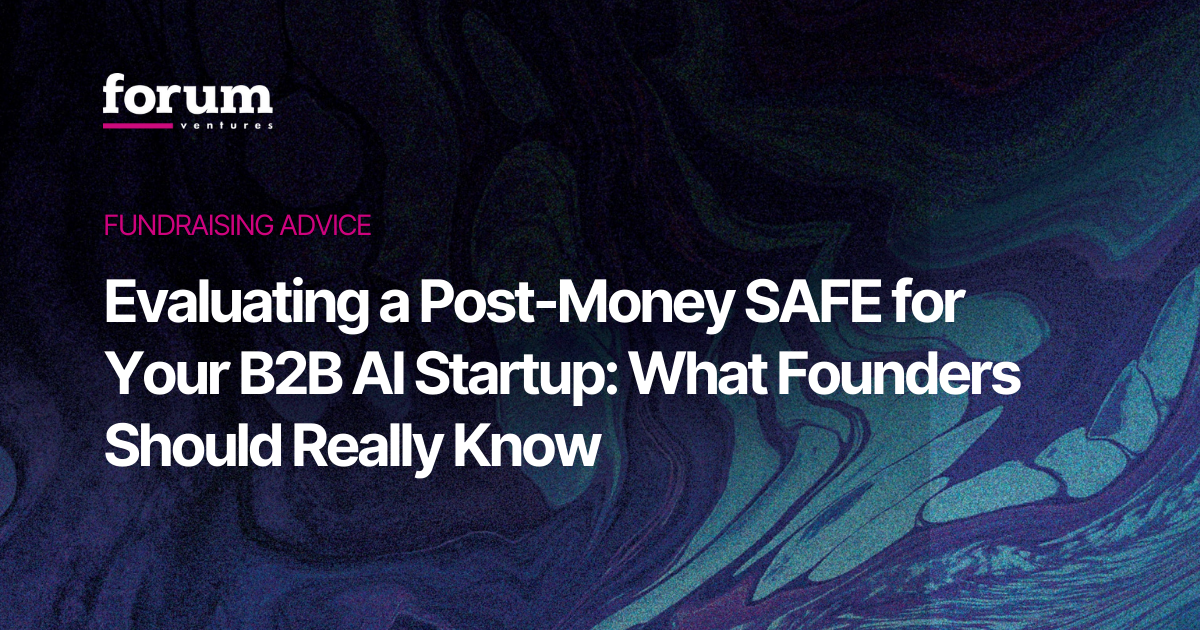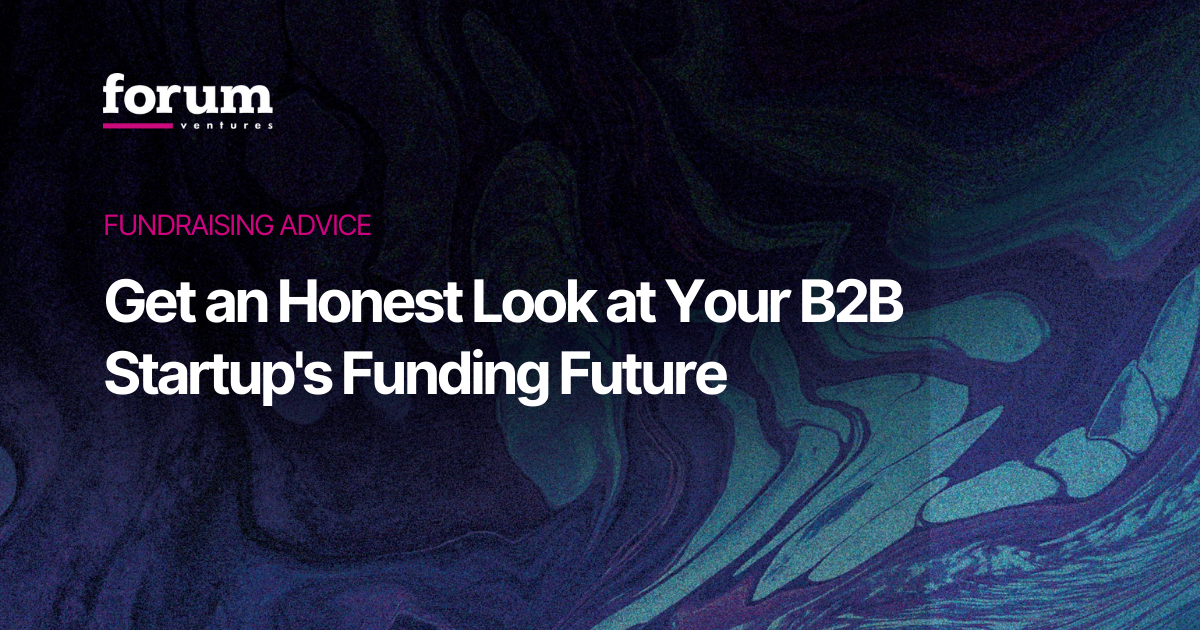Starting a business isn’t easy -- especially as a first-time founder -- but with the right guidance and an organized approach, you can validate your concept and bring your vision to life. Concept validation is essential for any business, especially B2B SaaS companies. It allows founders to assess the viability of their product idea and make necessary adjustments before investing too much time, effort, and resources into it. The concept validation process can be a long and complex one, but the rewards are well worth it.
At Forum, we strive to support startup founders in their journeys from Day 1. This guide will walk you through the six key steps of validating your B2B SaaS idea: start with a problem worth solving, define revenue streams, understand customer needs, analyze competitors and market share, create a viable product, and establish product-market fit. With each step, we’ll offer up actionable tips and advice on how to make sure your business is ready for success. So let's get started!
Step 1: Start with a Problem Worth Solving
Before you even think about starting a company or pitching to VCs, you need to make sure your B2B SaaS idea is solving a real, significant problem for your target customers. As a first-time founder or even a seasoned founder, its easy to get ahead of ourselves, but its important to start with the fundamentals. Talk to potential users, conduct market research, and ask yourself if your solution is addressing a pain point that's not already adequately covered by existing products or services.
Identify and address a personal issue.
“The number one rule for any SaaS business should be to solve your own, real problems and not someone else's problems. Only by solving a problem, you have struggled with yourself will you fully appreciate how to solve the problem in the best possible way.” — Uwe Dreissigacker, founder and CEO of InvoiceBerry.
Having experienced firsthand the challenges of starting SaaS businesses, we understand the importance of having a problem-solving mindset. By honing our skills in problems that affect us personally, we can come up with solutions that are more effective in tackling those issues. Solving our own struggles ensures that we have an intimate understanding of the issue at hand and can approach it in a holistic manner.
Use your deep domain expertise of an industry to solve a problem
Having a great idea for a B2B SaaS product is only the first step in launching a successful business. In order to make sure that the concept is viable, founders need to validate their ideas and ensure that there is an existing market demand before investing time, money and effort into developing their product.
Leveraging your knowledge and deep domain expertise of the industry you are targeting can help you validate your concept and give you a better chance of success.
“I had industry experience and knew that there was a big void to be filled for small and medium-sized businesses that could not afford to pay for local servers and an IT team. We created UpKeep to fill this void—a cloud-based solution that was affordable for any size business.” — Ryan Chan, founder of UpKeep.
Step 2: Define Revenue Streams & Pricing Models
Defining revenue streams and pricing models for your B2B SaaS solution is one of the most important steps you can take as a startup founder to ensure your company's success. Depending on the type of product or service you’re offering, there may be a variety of options available to you. It’s important to do your research and understand which of these models will work best for your business.
For example, subscription-based pricing is becoming increasingly popular among B2B SaaS companies as it allows customers to pay for access over time instead of paying up front. Alternatively, usage-based pricing enables businesses to pay only for the features they actually use, helping them save money in the long run. When setting prices, consider factors such as customer demand, competitive landscape, and cost of production so that you can stay competitive and maximize profits.
Understand the Needs of Your Target Audience
A deep understanding of your target audience is essential to the success of your B2B SaaS concept. To ensure that you’re creating a product or service that will meet their needs, it’s important to do some research into who they are, their pain points, and what solutions they’re looking for.
- Start by outlining the demographics of your ideal customer:
- What industry do they work in?
- Are there any specific job roles within this industry that would benefit from your solution?
- What pains and challenges do they face on a daily basis?
- How can your product help them solve these problems?
Once you have a clear picture of who would benefit most from your product or service, you can start developing features and functionalities that directly address their needs. This will not only make your offering more attractive to potential customers but also increase customer retention rates over time as users find value in the solutions you provide.
Analyze Competitors & Market Share
It’s important to stay informed of the competition when developing and validating your B2B SaaS concept. To make sure that your product stands out in an already saturated market, you should take the time to analyze competitors and their share of the market.
Start by researching competitors to gain a better understanding of what they offer, how users interact with their products, and any weaknesses they may have. Next, look into their pricing models and customer segmentation strategies. This will help you determine where there are gaps in existing offerings that you can fill.
Finally, take a look at their market share. How much of the total market do they control? Are there any trends or changes that could affect your ability to compete? Keeping track of this information will ensure that you are always one step ahead of the competition when it comes to B2B SaaS validation.
Outline a Product Roadmap & Timeline for Development
Developing a product roadmap and timeline for your B2B SaaS concept is essential for success. Your product roadmap should include all the steps you need to take from concept to completion, as well as a timeline for each stage of development. It should also outline your key milestones, such as launching a minimum viable product (MVP), testing and user feedback, and scaling up operations.
When creating your product roadmap, it’s important to consider both short-term and long-term goals. You should also factor in any external factors that could affect your timelines, such as market trends or customer feedback. With a detailed roadmap and timeline in place, you’ll be able to easily track progress and ensure that your B2B SaaS concept moves forward on schedule.
Step 3: Create a Viable Product
The next step in validating your B2B SaaS concept is to create a viable product. This involves taking the idea from its conceptual stages and turning it into an actual, functioning product that will solve the needs of your target customers. To do this, you’ll need to develop the user interface and design, as well as build out the back-end infrastructure. You’ll also need to create a minimum viable product (MVP) in order to test your concept with real users and gather feedback. Building out the MVP should be your main focus at this stage—it should include all of the essential features needed for users to engage with the product, but shouldn’t be too complex or overwhelming. Once you have an MVP ready, you can move on to testing and refining the product until it’s ready for launch.
Having a viable product is the foundation for success in any B2B SaaS concept, and with the right MVP in place, you'll be well on your way to bringing your idea to life. Now it's time to research and develop your offering; get ready to take your concept even further!
Research and Develop Your Offering
At this point, you'll want to start researching and developing your offering. This will involve analyzing the market, understanding target customer needs and wants, researching competitors, and more. It's also important to keep in mind that customer feedback is key—you should be talking to potential customers throughout your research process in order to get their insights and refine your product accordingly.
As a first-time founder, it will be even more beneficial to form relationships with industry experts who can provide invaluable advice on how to approach the market, what features would be most useful for users, etc. Last but not least, think about the pricing structure for your B2B SaaS concept—while pricing strategies vary from product to product, it's important to come up with a plan that makes sense for both you and your customers.
Research and development are essential steps when validating a B2B SaaS concept, so make sure you dedicate enough time and resources here. By doing so, you'll have a better understanding of the target market and be able to create an offering that resonates with customers.
Test and Iterate on Your Prototype/MVP
Once you've done your research and developed an offering that resonates with customers, the next step is to create a prototype or MVP (minimum viable product). This is essentially a testing version of your B2B SaaS concept, used to show potential investors, partners, and customers how it works. A good prototype should include the core features of your product as well as a working user interface. You can also add extra bells and whistles if you'd like, but it's important not to get too caught up in perfecting the details here—after all, this is just a testing version.
Once your prototype/MVP is ready for action, you'll want to start testing and iterating on it. This means gathering feedback from users and making adjustments based on their comments—for example, adding new features or refining existing ones. The goal here is to create a product that meets customer needs while still being cost-efficient—so don't be afraid to make changes as needed! Keep in mind that this process may take some time; don't expect everything to fall into place overnight. But with patience and dedication, you'll eventually have a finished product ready for launch!
Solicit Feedback from Prospective Customers
Gathering feedback from prospective customers is a key part of validating your B2B SaaS concept before you begin to think about expanding into the market and starting the fundraising process. After all, you can develop the most innovative technology in the world, but if it doesn't fit customer needs, it won't be successful. Fortunately, there are several ways to acquire meaningful feedback from potential users.
The first step is to reach out to your target audience and ask them questions about their needs and desires. This could include surveys, focus groups, and interviews—all of which can provide valuable insight into what customers need from your product. You should also consider speaking with industry experts and influencers who may have an understanding of the market that you don’t yet possess.
Finally, don’t forget to solicit feedback on any prototypes or MVPs that you build. Showing a working version of your product will give prospective customers a better understanding of how it works and how it might benefit them in the long run. With thoughtful communication and meaningful dialogue, you’ll be able to gain invaluable information about what customers want from your B2B SaaS concept.
Make Necessary Improvements Based on Feedback
Once you've gathered feedback from prospective customers, it's time to make necessary improvements based on what you've heard. Depending on the type of feedback you receive, this could involve tweaking existing features, adding new ones, or even changing the product’s core purpose. No matter what adjustments need to be made, it’s important that you take the time to ensure your product is meeting customer demands.
One of the best ways to do this is by creating a roadmap for your B2B SaaS concept and mapping out any changes based on customer feedback. This will help keep everyone on the same page and ensure that all improvements are in line with user expectations. Additionally, focus on any updates around solving customer pain points while also addressing other areas such as usability and scalability. With these considerations in mind, you can rest assured that your product will be well-received by your target audience.
Step 4: Establish Product-Market Fit
Once you've determined the features of your B2B SaaS concept, it's time to test and validate them to ensure they meet the requirements of your target customer. This is where establishing product-market fit comes in. Product-market fit is the degree to which a product meets the needs of a given market, and it's essential for successful B2B SaaS products.
To establish product-market fit, you'll need to conduct extensive user testing and gather feedback from potential customers. This can be done through focus groups, online surveys, or even one-on-one interviews with users. By collecting this data, you'll be able to better understand how customers perceive your product and what areas could still use improvement. Once you have an understanding of customer preferences, you'll be able to make necessary adjustments or add new features that will help make your B2B SaaS concept more marketable.
By establishing product-market fit, you can ensure that your B2B SaaS concept is meeting customer needs. In the next section, we'll go over how to conduct customer discovery interviews and analyze and refine your value proposition, as well as distribute free trials to prospective users and use data analytics to track performance and engagement. So, don't miss out on this invaluable opportunity to make sure your product is a hit!
Conduct Customer Discovery Interviews Analyze & Refine Value Proposition
Conducting customer discovery interviews is a great way to get an understanding of customer preferences and see how your B2B SaaS concept fits into the market. Interviews allow you to learn first-hand from customers what they like and don't like about your product and how it can be improved. Additionally, interviews provide direct insight into customer needs that can help you refine your value proposition.
Once you've conducted interviews and have a better understanding of customer needs, you can distribute free trials to prospective users. This will give them the opportunity to test out your product without any risk, allowing them to make an informed decision on whether or not they want to invest in it. Free trials are also an effective way for you to gauge user engagement and track performance metrics such as usage rates and feature adoption rates. Lastly, utilizing data analytics allows you to further analyze usage trends and measure the success of new features. By doing this, you can ensure that your product is meeting customer requirements and optimize its performance accordingly.
Step 5: Raise Funds & Form Partnerships
Once you have validated your B2B SaaS concept and gathered feedback from customers, it's time to start the fundraising process. To do so, you must create a detailed business plan that outlines your product vision and potential revenue streams. Additionally, reach out to angel investors and potential partners to secure venture capital investment. Make sure to prepare for the due diligence process by providing potential investors with financial statements, market research, customer data, and more. Execute the fundraising process within a set period of time and consider additional financing options such as crowdfunding or other alternative sources of funding. Analyze the growth rate of portfolio companies in order to get an understanding of what successful companies look like in your industry. Finally, leverage innovative companies as reference points when pitching your product to investors. Doing this will demonstrate that you have done your homework and understand the competitive landscape.
- Create a Detailed Business Plan
- Reach Out to Angel Investors & Potential Partnerships
- Prepare for Due Diligence Process
- Execute the Fundraising Process within a Set Period of Time
- Consider Additional Financing Options (e.g. Crowdfunding)
- Analyze the Growth Rate of Portfolio Companies
- Leverage Innovative Companies as Reference Points
Step 6: Overcome Biggest Challenges: Product Launch
Once you have secured funding, it's time to focus on the biggest challenges that come with launching a B2B SaaS product. These include scaling quickly, developing an efficient customer onboarding process, and staying ahead of the competition. To scale quickly, you must find ways to reduce costs and optimize operations while maintaining quality standards. Developing an efficient customer onboarding process is essential for increasing retention rates and user satisfaction. Lastly, staying ahead of the competition requires being proactive in identifying industry trends and adapting your product accordingly. By focusing on these three key areas, you can create a strong foundation for success and ensure your B2B SaaS concept continues to thrive.
In conclusion, the concept validation process is challenging and can be a long process for first-time founders and seasoned founders alike. However, it is essential to put in the necessary steps in order to create a successful and venture-backable SaaS company.
Forum’s venture Studio helps founders and aspiring entrepreneurs validate concepts and launch them into the market. Learn more and let’s build together!
For more founder-focused content and to receive resources like this directly to your inbox, subscribe to our "Midnight Text" Newsletter!
.avif)
.avif)

.avif)

.svg)





.avif)

